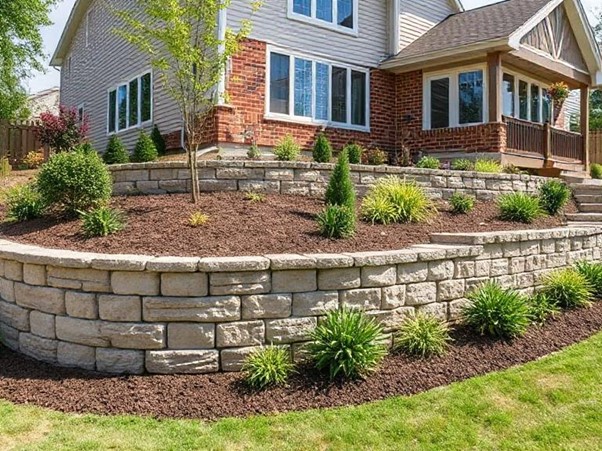Have you ever looked at your sloping garden and wondered how to make better use of that wasted space? Perhaps you’ve noticed soil creeping down towards your house after heavy rain? Or maybe you’re simply dreaming of creating those stunning terraced gardens you’ve seen in magazines?
Retaining walls might just be the answer you’re looking for. These versatile structures do far more than just hold back soil – they’re game-changers for Australian properties, transforming challenging landscapes into functional, beautiful outdoor spaces. From preventing erosion to creating level areas for entertaining, retaining walls offer a wealth of benefits that many homeowners overlook.
Throughout this guide, we’ll explore everything from the basics of what retaining walls are and their essential purposes, to the aesthetic and practical advantages they bring to your property. Whether you’re dealing with a steep block, drainage issues, or simply want to level up your landscaping game, you’ll discover how retaining walls can solve multiple problems whilst adding significant value to your home.
What Is a Retaining Wall and Why You Need One
A retaining wall holds back soil, especially on sloped or uneven terrain. Its core function is to manage soil and water pressure, creating level surfaces where needed. But beyond that, retaining walls offer multiple benefits: they control water runoff, prevent soil erosion, and provide crucial support on properties with elevation changes.
In Australia’s diverse terrain, retaining walls are a common sight, helping homeowners manage stormwater, enhance curb appeal, and protect the structural integrity of their properties.
Popular Types of Retaining Walls in Australia
- Timber Sleeper Walls: Affordable and natural-looking, great for small garden walls.
- Concrete Block Walls: Durable and versatile; can be rendered or painted.
- Natural Stone Walls: Ideal for classic or heritage properties.
- Poured Concrete Walls: Strong, sleek, and highly customizable.
Each material has pros and cons, so your choice should reflect your budget, style, and landscape needs.
Top Benefits of Retaining Wall Installation
- Prevents Soil Erosion
Australian weather—with heavy rains and dry spells—can wreak havoc on unprotected soil. Retaining walls prevent valuable topsoil from washing away, maintaining your landscape’s structure and health. They also protect nearby buildings, garden beds, and boundary lines from potential damage.
- Increases Property Value
A professionally built retaining wall enhances both form and function. It makes your outdoor area more usable and appealing factors that real estate agents say can add value to your property. Buyers are often drawn to properties that demonstrate good drainage, safety, and landscaping.
- Enhances Aesthetic Appeal
Modern retaining walls can look as good as they perform. Timber offers a warm, natural vibe, while concrete options can be molded or coloured to suit contemporary tastes. Use them to build garden beds, seating, or multi-level entertaining zones.
- Adds Privacy and Definition
Walls also serve as subtle dividers, marking out zones for different uses. They can double as privacy screens or create secluded spots for relaxation and entertaining.
Design and Material Options to Match Your Style
Modern Timber Walls
Perfect for blending into natural landscapes. Use Australian hardwoods like spotted gum or ironbark for durability and visual charm. Horizontal designs add width, while vertical sleepers give height and drama.
Decorative Concrete Walls
Great for modern properties. Textured or patterned finishes mimic stone or timber. Curved designs, built-in lighting, and integrated planters create standout features.
Practical Uses in Everyday Landscaping
- Backyard Privacy Walls
Use taller retaining walls strategically to shield your backyard from neighbours, without the harshness of a tall fence. Combine with planting for a softer effect.
- Lawn Retaining Solutions
Retain soil to protect grassy areas from erosion. Design with mowing in mind: include mowing strips or recessed edges to make upkeep easy.
- Timber for Contemporary Homes
Timber suits a wide range of home designs and climate zones. For durability, use H4 or H5-treated pine or choose resilient hardwoods. Combine timber with steel or concrete for added stability and modern appeal.
- Maintenance Tips for Timber Walls
Check annually for rot or termites. Keep weep holes clear and apply timber oils or stains every few years. Proper maintenance can double the life of your retaining wall.
Planning and Compliance Considerations
Know the Rules
Walls under 600mm typically don’t need council approval. Higher walls, or those supporting driveways or structures, often do. Engineering may be required for walls over 1 metre.
DIY vs. Professional Installation
Small garden walls may suit confident DIYers. For taller or more complex jobs, hire professionals to ensure structural integrity and regulatory compliance. Pros also handle permits and offer warranties.
Conclusion
Retaining walls bring both visual and practical improvements to your landscape. Whether you’re preventing erosion, increasing yard usability, or boosting your home’s value, a well-designed retaining wall can transform your outdoor space. Choose the right material, follow local rules, and decide whether DIY or professional installation suits your needs. The result? A safer, more beautiful, and more functional property.
Ready to enhance your landscape with a durable and stylish solution? Whether you’re dealing with sloping land or want to boost your home’s curb appeal, a professionally built retaining wall in Doncaster can make all the difference. Contact our local experts today to discuss your project and get a free quote!





